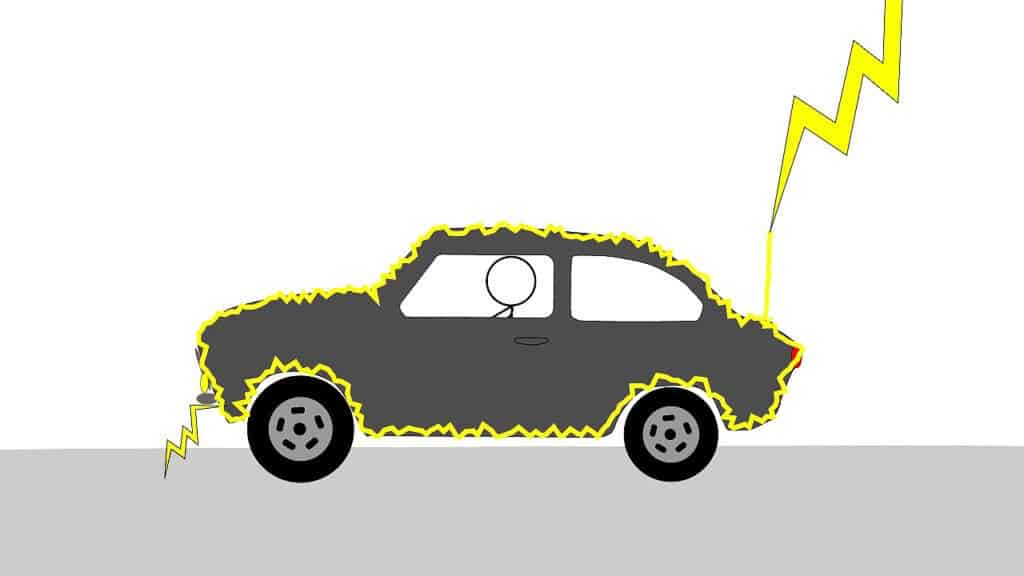
There’s a good chance the plane you boarded during a flight got hit by lightning. According to the Federal Aviation Administration, a plane is struck by lightning every 1,000 flight hours or so. There are around 10,000 planes in the air at any given moment, so the odds of one of them being hit by lightning are pretty high. But somehow there has not been one single accident or fatality owed to lightning in aviation history — and we have physics to thank.
A plane’s body is designed to be completely encapsulated with aluminum, which allows the electrical current to flow solely through the outside or outer shell of the planet and out through the tail, keeping the inside of the plane free of electrical charge. Essentially, an airplane is a giant Faraday cage.
What’s a Faraday cage?
A Faraday cage, also known as a Faraday shield, is a conducting enclosure that shields anything inside from electromagnetic fields by redistributing the electric charges at the surface of the conductor, which in turn cancels the field’s effect in the interior of the cage. The concept and underlying physical phenomenon were first demonstrated by English scientist Michael Faraday in 1836.
Faraday performed many experiments in the early 19th century that greatly contributed to our understanding of electromagnetism. The English physicist and chemist was the first to show that a magnetic field produces an electric current, discovered the effect of magnetism on light, and invented the first electric motor and dynamo.
During one of these experiments, Faraday noticed that an electrical conductor only carries an electrical charge on its surface, while the interior of the conductor is not affected at all.

Faraday set out to investigate this phenomenon at a large scale. To this aim, he lined all the walls of a room with metal foil, then fired a high-voltage current from an electrostatic generator through the outside of the room. Using an electroscope, a device that detects electrical charge, Faraday showed that only the walls carried electrical charge while the interior of the room was completely devoid of charge.
Earlier, Benjamin Franklin, a major figure in his own right for the American Enlightenment and the history of physics, electrified a silver pint (tankard) and lowered an uncharged cork ball attached to a silk thread. Although the ball was lowered until it touched the bottom of the metal enclosure, the ball wasn’t attracted to the charged interior sides of the pint. But when Franklin withdrew the cork and pointed it near the pint’s exterior, the ball was immediately drawn to its surface.
Decades later, Faraday replicated Franklin’s research with a twist in his now-famous ice pail experiment, during which he lowered a charged brass sphere into a metal cup. As expected, his results agreed with Franklin’s original work.
These experiments validated a fundamental tenet of electromagnetism: an electrical current flowing through a conductor only resides on the outer surface and the inside of the conductor is not affected by the external charge. Later developments in field theory refined the physics of these observations, showing that the charge flowing through a conductor is actually redistributed resulting in a net electrostatic field within the conductor of zero.
How a Faraday cage works

This leads us to the Faraday cage, which can be viewed as a hollow conductor that shields anything inside from external electrical charge or radiation. Because the Faraday cage distributes the charge around the exterior of the shield, charges within the interior are canceled out. The shield also works against radio waves and microwaves.
A Faraday cage can be a continuous shell-like material like the hull of an airplane or a mesh. The size of the gaps in the screen or mesh alters the cage’s properties, which can be adjusted to exclude only certain frequencies and wavelengths of electromagnetic radiation.
The typical Faraday cage is made of grounded wire mesh or parallel wires. The wires have to be made of conductive materials, such as aluminum or copper, and the coating has to be perfectly closed from one to another.
However, not all electromagnetic radiation and fields are blocked by a Faraday cage. Stable or slowly varying magnetic fields like Earth’s magnetic field can penetrate a Faraday cage, which explains why a compass will still work inside one. Near-field high-powered frequencies like HF RFID, which are used in contactless payments, can also penetrate the shield.
The applications for Faraday cages are manyfold. In fact, a lot of our modern electronic hardware wouldn’t be able to function properly or at all were it not for incorporating Faraday shielding in their design.
Besides protection against external electromagnetic radiation and electrical discharge, Faraday cages also block electromagnetic noise that can hamper the performance of electronic devices. And since a cage keeps things out but also inside, a Faraday cage can also be useful when you want to prevent electromagnetic energy radiated from internal components from escaping the enclosure.
For instance, the best example of a Faraday cage is right inside your kitchen. Microwave ovens have a metal shell that prevents the microwaves inside the oven from leaking into the environment. Inside hospitals, Faraday cages help MRI machines to scan tissues inside the human body. An MRI room has to be shielded otherwise external electromagnetic fields could ruin the diagnostic images. The military also routinely incorporates Faraday cages into vehicles and bunkers to protect its assets from electromagnetic pulses. In science, this shielding reduces the noise in analytical chemistry tests for sensitive measurements.


